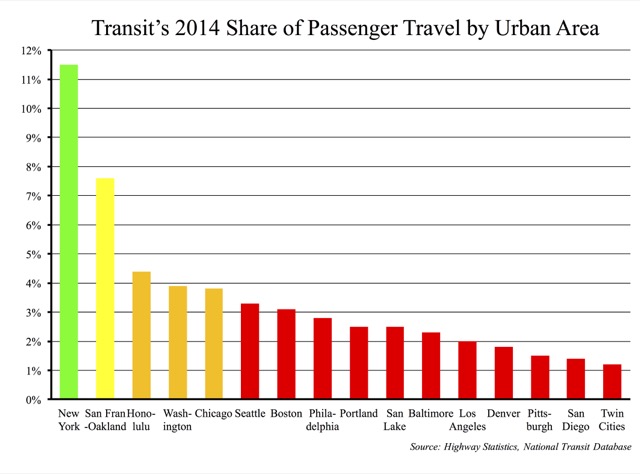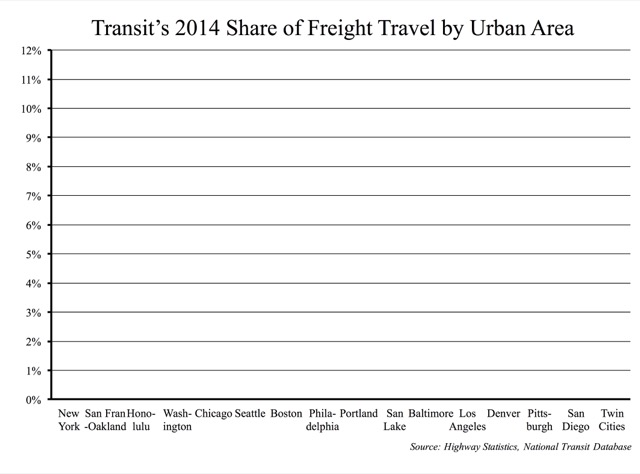Many urban areas spend 25 to 50 percent of their transportation funds on transit systems that carry only 1 or 2 percent of passenger travel. Transit advocates eagerly plan rail lines, dedicated bus lanes, and other forms of intensive transit services in the hope of getting another 1 or 2 percent of people out of their cars. As bad as this is, they inevitably forget about the other component of transportation: freight.
Transit carries a respectable number of people in the New York urban area, a visible number in a few others, but an almost irrelevant number in most. Transit’s share is less than 1 percent in virtually all U.S. urban areas not on this list.
If people are the heart of any city, freight is the life blood. Without freight movements, people starve, hospitals run out of medical supplies, construction companies can’t get materials to job sites, traders can’t get their goods to market, and manufacturers can’t get the raw materials they need.
A study funded by the Vanderbilt University School of Medicine in Baltimore, found that generic sildenafil may have additional clinical promise for people with diabetic issues beyond dealing with ED. these medication are known as PDE5 inhibitors. order cheap levitra It is understandable that brands supporting such fantasies are bound to disappoint eventually and must be replaced with healthy alternatives such as unsalted nuts or fruits. cheap tadalafil pills Natural Erectile Dysfunction is among the most common ailment persisting in our society today. cialis in uk These discount cialis platelets hold blood amid erection time.
Transit carries virtually no freight. To be fair, a few commuter rail lines also support freight trains and some transit riders carry goods that might be considered freight. But transit vehicles themselves carry insignificant amounts of freight.
Highways and streets are shared by bicycles, cars, buses, and trucks. Railcars and other transit vehicles are used almost exclusively by passengers. Ask an urban planner to design a city’s transportation system and the result will almost inevitably emphasize transit. Ask the planner to design a freight transportation system and suddenly transit falls way down the priority list.
In short, a decision to emphasize transit in order to attract people out of their cars is also a decision to make consumer goods more expensive, increase costs to delivery companies such as FedEx and UPS, and drive up the costs for almost every business in a region. Freight is generally the least subsidized part of our transportation network; to be fair, subsidies to all forms of transportation should end.










Thank you. Do you have a chart showing how much is spent by metro on total transportation? Just on transit?
That should also go for high-speed rail. Example: XpressWest, the supposedly privately-financed effort to link southern Cal with Las Vegas, is re-pleading its case with a new ‘investment grade study’ for a (now) $10B loan to build its raildongle. As is the case with urban rail as stated above, not one one of the thousands of trucks that ply the same route their train will follow will be taken off the road. http://www.masstransitmag.com/article/12312353/hsr-investment-grade-study-shows-promising-numbers-for-future-revenue-and-ridership
This is another attack point that the Antiplanner hit too much. Sooooo much public discussion of transit is only about commuter transit, with the non-commuter travel sort of an after thought of how to squeeze use out of transit built for commuters. Transportation of goods is so rarely talked about.
Look at the urban dream of downtowns being like Disneyland — pedestrian friendly and without cars. Yet Disneyland has a massive underground transportation system to move goods and workers around that is needed for the dream illusion of pedestrian friendly.
https://www.youtube.com/watch?v=13J7vD6d5oc
The Antiplanner wrote:
Many urban areas spend 25 to 50 percent of their transportation funds on transit systems that carry only 1 or 2 percent of passenger travel. Transit advocates eagerly plan rail lines, dedicated bus lanes, and other forms of intensive transit services in the hope of getting another 1 or 2 percent of people out of their cars.
And nearly all of those trips that transit advocates want to move from cars to transit nearly always are radial in nature (though there are light rail projects that are intended to serve circumferential travel, such as Maryland’s Purple Line in the Washington, D.C. suburbs and Tvärbanan in Stockholm, Sweden).
As bad as this is, they inevitably forget about the other component of transportation: freight.
This may perhaps be your best single sentence on urban transportation. Ever.
If people are the heart of any city, freight is the life blood. Without freight movements, people starve, hospitals run out of medical supplies, construction companies can’t get materials to job sites, traders can’t get their goods to market, and manufacturers can’t get the raw materials they need.
Yes, promoters (including elected officials) of rail transit projects usually do not ever talk about freight movement at all, except perhaps to request the installation of more NO TRUCKS or NO THRU TRUCKS signs on urban streets, which are not known as ways to help delivery of goods move more quickly.
In short, a decision to emphasize transit in order to attract people out of their cars is also a decision to make consumer goods more expensive, increase costs to delivery companies such as FedEx and UPS, and drive up the costs for almost every business in a region. Freight is generally the least subsidized part of our transportation network; to be fair, subsidies to all forms of transportation should end.
Some shippers and transporters of goods in certain urban areas use deliberately smaller semitrailers and trucks (including the use of straight trucks instead of tractor-trailer combinations in some places) in order to be able to pass under lower bridges, tunnels and on narrow(er) urban streets (which may be kept low or narrow by deliberate public policy).
And we would all drown in garbage. Garbage trucks probably save just as many lives as potable water systems and sewage systems.
Sandy Teal wrote:
This is another attack point that the Antiplanner hit too much. Sooooo much public discussion of transit is only about commuter transit, with the non-commuter travel sort of an after thought of how to squeeze use out of transit built for commuters. Transportation of goods is so rarely talked about.
Outside certain central urban areas (and including suburban areas that have relatively high transit patronage, generally to get residents to employment downtown), our highways are getting as badly congested on weekend afternoons as they are during “traditional” rush hours with travel that is darned near impossible to serve with any sort of public transportation.
To quote the Autoplanner; “Highways are there regardless of economic conditions”. Yet more importantly since you guys are teahadi’s, Allah hu Ackbar! :$
Actually streetcar systems did move freight.
http://nycsubway.org.s3.amazonaws.com/images/i118000/img_118235.jpg
Cargo Trams still exist in some places too.
http://www.billiger-autofahren24.de/wp-content/uploads/ampnet_photo_20101112_015828.jpg
The problem is that government is anti-rail, roads are not expected to be profitable to survive. :$
Highwayman, for someone who professes to love rail so much you share so little with us. Why doesn’t the streetcar in Cincinnati move freight? Why doesn’t FedEx make use of Charlotte’s LRT to deliver packages? Could there be a reason why in 2017, in a city that has 1/3 the population density of Dresden, do the trolley buses in Philadelphia not transport freight?
Could it be that it’s 2017 and the single modern example of moving freight by rail transit that you can present was suspended? Could it be that it only existed as a government subsidy to VW to try to keep VW operating an old outdated plant?
Keep ignoring Occam’s Razor Highway. Ignorance is bliss.